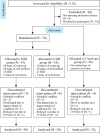Effect of maximal-intensity and high-intensity interval training on exercise capacity and quality of life in patients with acute myocardial infarction: a randomized controlled trial
- PMID: 37906165
- PMCID: PMC10938035
- DOI: 10.23736/S1973-9087.23.08094-2
Effect of maximal-intensity and high-intensity interval training on exercise capacity and quality of life in patients with acute myocardial infarction: a randomized controlled trial
Abstract
Background: An increase in V̇O<inf>2max</inf> is important for acute myocardial infarction morbidity, and recurrence rate and intensity have been suggested as important factors in improving V̇O<inf>2max</inf>.
Aim: The aim of this study was to compare the effects of maximal-intensity interval training (MIIT) and high-intensity interval training (HIIT) on exercise capacity and health-related Quality of Life (HRQoL) in patients with acute myocardial infarction (MI) at low and moderate cardiac risk in cardiac rehabilitation (CR). This study secondarily aimed to compare the effects of hospital-based phase II CR and usual care.
Design: This study is a randomized controlled trial.
Setting: Outpatient Rehabilitation Setting.
Population: Fifty-nine patients with acute MI were randomly assigned to the MIIT (N.=30) or HIIT (N.=29) group, and 32 to the usual care group.
Methods: Twice a week, an intervention was conducted for nine weeks in all groups. The maximum oxygen intake (V̇O<inf>2max</inf>) and MacNew Heart Disease HRQoL were evaluated before and after intervention.
Results: A significant interaction was observed between time and group for V̇O<inf>2max</inf> (P<0.001). The MIIT group showed greater improvement than those exhibited by the HIIT and usual care groups (P<0.05). Similarly, a significant time and group interaction was observed on the MacNew Global, Physical, and Emotional scales (P<0.05), but not on the social scale (P>0.05).
Conclusions: Compared to HIIT and usual care, MIIT significantly increased the V̇O<inf>2max</inf> and was as safe as HIIT in patients with acute MI with low and moderate cardiac risk in CR. Additionally, MIIT and HIIT were superior to usual care in terms of improving the HRQoL.
Clinical rehabilitation impact: Our results suggest that increased intensity in phase II CR could result in better outcomes in terms of V̇O<inf>2max</inf> increment in patients with acute MI and low and moderate cardiac risk in CR.
Conflict of interest statement
Figures
References
-
- World Health Organization. Cardiovascular diseases (DVDs); 2021 [Internet]. Available from: https://www.who.int/en/news-room/fact-sheets/detail/cardiovascular-disea... [cited 2023, Oct 11].
-
- Squires RW, Kaminsky LA, Porcari JP, Ruff JE, Savage PD, Williams MA. Progression of Exercise Training in Early Outpatient Cardiac Rehabilitation: an official statement from the american association of cardiovascular and pulmonary rehabilitation. J Cardiopulm Rehabil Prev 2018;38:139–46. https://www.ncbi.nlm.nih.gov/entrez/query.fcgi?cmd=Retrieve&db=PubMed&l... 10.1097/HCR.0000000000000337 - DOI - PubMed
-
- Ambrosetti M, Abreu A, Corrà U, Davos CH, Hansen D, Frederix I, et al. Secondary prevention through comprehensive cardiovascular rehabilitation: From knowledge to implementation. 2020 update. A position paper from the Secondary Prevention and Rehabilitation Section of the European Association of Preventive Cardiology. Eur J Prev Cardiol 2021;28:460–95. https://www.ncbi.nlm.nih.gov/entrez/query.fcgi?cmd=Retrieve&db=PubMed&l... 10.1177/2047487320913379 - DOI - PubMed
-
- Ross R, Blair SN, Arena R, Church TS, Després JP, Franklin BA, et al. American Heart Association Physical Activity Committee of the Council on Lifestyle and Cardiometabolic Health ; Council on Clinical Cardiology; Council on Epidemiology and Prevention; Council on Cardiovascular and Stroke Nursing; Council on Functional Genomics and Translational Biology; Stroke Council. Importance of Assessing Cardiorespiratory Fitness in Clinical Practice: A Case for Fitness as a Clinical Vital Sign: A Scientific Statement From the American Heart Association. Circulation 2016;134:e653–99. https://www.ncbi.nlm.nih.gov/entrez/query.fcgi?cmd=Retrieve&db=PubMed&l... 10.1161/CIR.0000000000000461 - DOI - PubMed
-
- Wenger HA, Bell GJ. The interactions of intensity, frequency and duration of exercise training in altering cardiorespiratory fitness. Sports Med 1986;3:346–56. https://www.ncbi.nlm.nih.gov/entrez/query.fcgi?cmd=Retrieve&db=PubMed&l... 10.2165/00007256-198603050-00004 - DOI - PubMed
Publication types
MeSH terms
LinkOut - more resources
Full Text Sources
Medical



